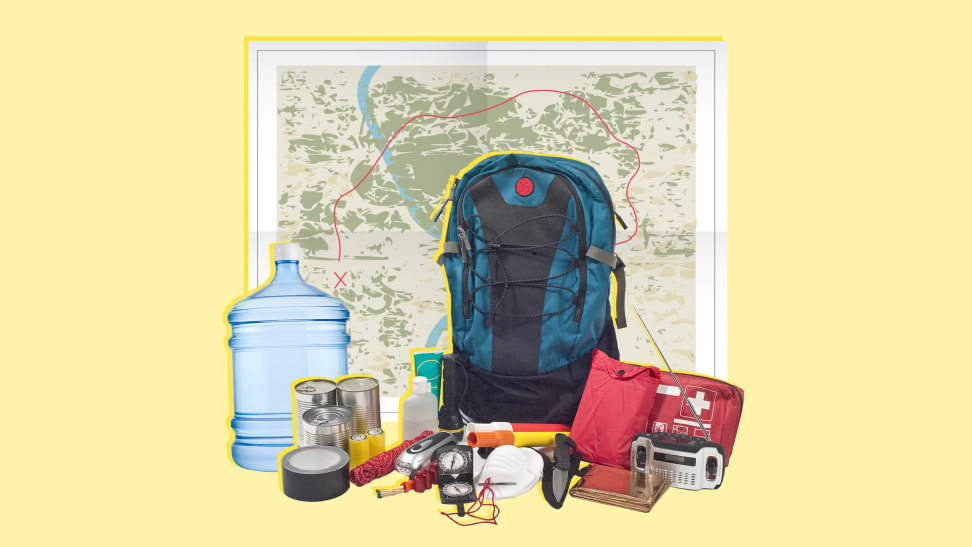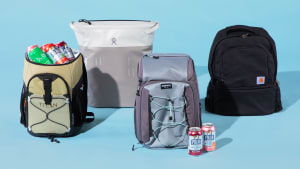Here’s how to create an evacuation plan ahead of severe weather
Severe weather evacuation plan—here’s how to create one
 Credit:
Reviewed / Getty Images / Hyrma / schfer
Credit:
Reviewed / Getty Images / Hyrma / schfer
Recommendations are independently chosen by Reviewed's editors. Purchases made through the links below may earn us and our publishing partners a commission. Prices were accurate at the time this article was published but may change over time.
Between the highly destructive wildfires in Maui and Canada, and Hurricane Hilary rocking the West Coast, it's been an active summer as far as natural disasters go. Wildfires and hurricanes aren’t going away anytime soon, as we’re only now approaching the height of hurricane season and we still have a few weeks until wildfire season ends. Unfortunately, thanks to climate change, natural disasters will become increasingly more common—warmer oceans due to global warming could lead to more hurricanes, and more intense ones at that.
Whether you’re preparing for upcoming disasters or future-proofing for years to come, you’ll be ahead of the curve if you create an emergency survival kit for your household. It turns out only one in four homeowners have made such preparations, according to Hippo Insurance’s June 2022 Homeowners Preparedness report.
Steve Wilson, a senior underwriting manager with Hippo Insurance, says, “The best form of disaster prevention is preparation.” He further notes that evacuation planning will look different depending on the type of climate threat and whether there is any prior warning.
“For instance, wildfire activity will require a fast evacuation, so having a checklist prepared with the location of all items you’ll want to take with you can maximize evacuation time, if time permits,” he says.
If you are not the one in four people who is prepared for a worst-case scenario in the face of impending extreme weather, read on to see how you can remedy this for your household.
How to prepare for a rainy day—or worse

The only thing worse than the unexpected emergency itself is not being prepared for one when it occurs.
Travelers insurance company recommends that households follow these precautionary steps in the event of an evacuation during a natural disaster:
- Designate a meeting place outside of the impacted area.
- Map out an evacuation route, plus alternatives, in case your primary route is blocked.
- Have a plan for communicating with family members, in case you are separated and are without cell service/access to a landline. (It also helps to have everyone’s number written down as backup if your phone dies and you can’t remember them.) Activate phone notifications so that all can receive important news alerts and updates.
- Fuel up your vehicle(s).
- Identify an individual outside of the affected area and share that person’s contact info with your family members. Pack your survival kit.
Have a “go bag” ready to go

The key to a useful "go bag" is stocking with everyday items that you need and use on a daily basis.
In the event you are evacuated from your home, it helps to have a well-stocked survival kit, often known as a “go bag,” to sustain the members of your household, including pets.
Regardless of the type of extreme weather you might be facing, Wilson recommends first addressing your family’s most pressing personal needs, such as specific dietary restrictions and medications, then going from there to create a more extensive home preparedness plan.
Ready.gov recommends including the following items:
- One gallon of water per person, per day (this is for sanitation as well as drinking)
- Several days’ worth of non-perishable food, and a manual can opener
- Prescription medicines, if applicable
- Infant formula and baby bottles, if applicable
- Pet food, if applicable
- Diapers and baby wipes, if applicable
- Battery-powered or hand crank radio
- Flashlight
- Cash and/or traveler’s checks
- Extra batteries
- First aid kit
- Whistle (as a help signal)
- Face masks
- Moist towelettes
- Trash bags
- Feminine hygiene products, if applicable
- Non-prescription medicines (pain relievers, antacids, etc.)
- Printed maps of local area
- Cell phone chargers or backup batteries
- Soap and hand sanitizer
- Prescription eyeglasses and contact lenses with solution
- Sleeping bag or blanket for each person
- Change of clothes and sturdy shoes
- Matches in waterproof container
- Paper cups, plates, and utensils
- Paper and pencil
Again, these are recommended items; your household may have other specific needs separate from those on this list.
Prepare your home for impact ahead of time

Ensure your property remains in the same condition as you left it with window boards, emergency alert devices and a secured roof.
If you are not faced with immediate evacuation, Wilson says there are measures you can take to protect your property. Your home insurance provider can offer more specific steps for both the type of home you have and the weather you are protecting it from, but here are some general precautions to take:
- Cover windows with shutters or plywood
- Install impact-resistant window panes
- Make necessary roof repairs and clean your gutters
- Trim back trees and shrubbery
- Secure or store loose items on your property, like patio furniture
- Install smart emergency alert devices, like smoke and flood alarms
- Keep a supply of tarps and other supplies to secure any damaged part of your home after the weather event has passed
Take inventory of your home and possessions

Taking inventory of your items will save you a lot of time and energy after the dust of an emergency event settles.
If you do have more time to carefully plan your evacuation, Angi Orbann, vice president of property for personal insurance at Travelers, says to take a video or pictures of each room of your home—you can also make an inventory list—so that you can have a record of your belongings for your insurance provider when making a claim.
“From a homeowners insurance perspective, we understand that there’s an emotional attachment to the home,” Orbann says. “Personal safety comes first for you and your family. And, that’s what insurance is there for: to help you in the event that something unfortunate would happen to your home.”
Should your home be faced with or affected by a destructive weather event like hurricane, tornado, or coastal flooding, calling your insurance company might not be the first priority on your list—again, safety first, says Orbann.
She does note, however, that making that call to the insurance company is important once homeowners do reach safety. Aside from any property damage sustained, homeowners may also have access to funds for short-term supplies and living expenses, until they are able to return home.
Think in terms of analog, not digital

Although it may seem a bit outdated, a paper map or an analog clock will never fail you like a digital device might.
You might be attached to various digital devices on a daily basis, but in an emergency situation, you and the members of your household will need an alternative plan if cell service is out or phone batteries die, advises Orbann.
This includes having paper maps detailing your primary and alternative evacuation routes. While online maps make it convenient to navigate roads on a normal day, when weather makes it difficult or impossible to travel on your pre-planned route, it helps to have a lay of the land.
The same goes for both communication and currency. You’ll note that there’s a hand crank radio included on this list, but it’s necessary for important news alerts when satellite radio and streaming services are down.
And, while travelers checks might seem downright archaic, having those—or at least some cash and/or personal checks on hand—will be very helpful if you need to make a purchase and credit card machines are offline.
Preparing for natural disasters isn’t the cheeriest of tasks for a homeowner, but it’s an important one for the safety of your household.
Wilson says that if you need more advice for creating an evacuation plan that fits your household’s needs, check in with your insurance provider, your local fire department, or another local government agency for guidance.






